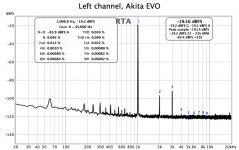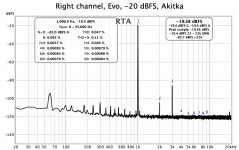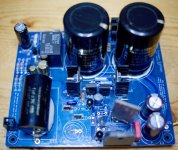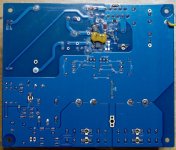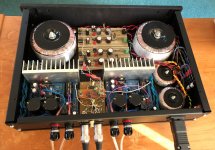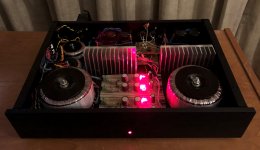Announcement : in 2019 I'll finish my amp. Promised. So beware, I'll be back with noobish silly questions!
Did I really said so?

Question, has Mauro’s page at webalice.it gone down? I hooked up an Evo and looked under the lid. It works fine, but the connections to the power transformer are not intuitive.
Using an Antek and the wires are connected green, green, Blue, Blue.
Hoped to look at the connection diagram. Guess I need to put a meter on it and see how the diodes connect to the main filter caps.
Using an Antek and the wires are connected green, green, Blue, Blue.
Hoped to look at the connection diagram. Guess I need to put a meter on it and see how the diodes connect to the main filter caps.
A real Evo measurement
Ran some sweeps with REW. Maybe it is all the years in the attic have baked it. But my Evo, Rev A does not measure as well as the FE.
It is capacitor coupled input, and not transformer like the Fremen.
Ran some sweeps with REW. Maybe it is all the years in the attic have baked it. But my Evo, Rev A does not measure as well as the FE.
It is capacitor coupled input, and not transformer like the Fremen.
Attachments
FE OPA828
I started this project in 2012 with Fremen Edition RC boards. I planned on trying different components, so I mounted the amp on a piece of scrap plywood and placed it in my living room. Alas, all these years later it is still sitting in my living room on that ugly plywood. I think it is finally time to put the amp in an enclosure and call this project done.
Of course, there were other projects, my LXmini powered by 4 FE's, a couple of tube pre-amps, a Pass F4. In the interim, the plywood FE was upgraded to the V1.5 and later boards and BOM (a nice improvement).
In the last year or so, I have been playing with jfet opamps based on George's work (another nice improvement). This year, I built a pair of r1.72 boards with the new OPA828 opamp and some component optimizing. The last few months, I have been listening and smiling a lot. This is the best sounding amp I have ever heard. It is time to call this project done. Of course, the enclosure is taking longer than I hoped, so I thought I should share the board build, even though it is still sitting on that ugly plywood.
OPA828
George suggested this opamp as he was playing with them in an Evo amp. Per the TI datasheet, “The OPA828 JFET is the next generation OPA627 and OPA827 operational amplifier (opamp), combining high speed with high DC precision and AC performance.”
Compared to the LM318, the OPA828 (mostly standard BOM) moves the image a bit closer with better instrument separation and a deeper sound stage. The OPA828 maintains the nice harmonics from the LM318, but gives clean, natural decay. Overall, I would describe the FE with OPA828 as transparent.
Build Issues
Stability – The other jfet opamps (OPA827. AD4627, and OPA627) are normally stable but will, on occasion, require a 4.7 or 5 pF silver mica cap across pins 2 and 6 of the opamp to restore stability. The OPA828 is a very fast opamp and the silver mica cap is a necessary starting point. However, it still requires even more help to keep it stable. George determined that C32 needs to change from 150 pF to 68 pF which we both confirmed resulted in a stable FE OPA828.
For that 68 pF cap, I tried silver mica, Corning glass CY30, and Rohm polystyrene caps at C32 (68 pF). Of these, the polystyrene cap was by far the smoothest and clearest sounding.
DC Offset
Each of my jfet opamp builds had more DC offset that I wanted. In the worst case, I had about 700 mV DC offset. This problem had me stumped for a while until George mentioned that he didn't have any DC offset problems but only used “no-clean” solder flux. I had been using Kester lead solder with #44 rosin flux.
I removed the opamp and several surrounding SMD resistors, cleaned them and the board carefully, and soldered them again with Chipquik SMD291 No Clean Tack Flux and Mundorf Msolder SilverGold with no clean flux. My new DC offset was 2 mV.
From this single experiment, I can't conclusively say that the flux was my problem, but it is a strong enough case that I recommend you use no clean flux on all SMD components. It appears that, no matter how completely you clean up after soldering, there remains some flux under the SMD components that may cause DC offset.
Component Tweaks
In the final build, I did some component tweaks that further improved the sound of the FE OPA828.
Resistors
The Caddock in R3 has been replaced with my homemade quartet resistor using Susumu KRL foil resistors.
I replaced most of the signal path resistors with Texas Components Z foil resistors. The resistors are R5, R6, R7, R8, R9, R10, R12, and R37. Most of these are SMD versions (ASM2575).
Those with sharp eyes will notice that a few of these SMD resistors look big compared to the others. Texas Components doesn't make 47k resistors in the smaller 0805 or 1206 sizes. These 47k resistors are 2010 size which really doesn't fit the pads on the boards. In order to use these, I carefully scraped the solder resist from the trace effectively extending the pad. That gave me the room to solder the bigger 2010 resistors to the appropriate place in the circuit.
Capacitors
In addition to the changes at C32, I am lucky enough to have some of the old stock ERO KP1834 for C7.
I tried several caps at C13. The Mundorf Supreme from the BOM is the most neutral and my favorite for this build. If I was braver, I might have removed C13 and gone DC coupled, but the difference in sound with the Supreme was very small, so elected the safer path.
One reason for going to a jfet opamp is the possibility to remove C9. Although the jfet with C9 in place might be an improvement over the LM318, I think a significant part of the value of the jfet opamps is removing C9.
Summary
In the end, I am really happy with the sound of this amp. The sound stage is deeper and the instruments rendered more realistically than any I have ever heard. Hats off to George for researching this tuning path and a huge thank you for all of the help. Now I have to finish off that enclosure.
Jac
I started this project in 2012 with Fremen Edition RC boards. I planned on trying different components, so I mounted the amp on a piece of scrap plywood and placed it in my living room. Alas, all these years later it is still sitting in my living room on that ugly plywood. I think it is finally time to put the amp in an enclosure and call this project done.
Of course, there were other projects, my LXmini powered by 4 FE's, a couple of tube pre-amps, a Pass F4. In the interim, the plywood FE was upgraded to the V1.5 and later boards and BOM (a nice improvement).
In the last year or so, I have been playing with jfet opamps based on George's work (another nice improvement). This year, I built a pair of r1.72 boards with the new OPA828 opamp and some component optimizing. The last few months, I have been listening and smiling a lot. This is the best sounding amp I have ever heard. It is time to call this project done. Of course, the enclosure is taking longer than I hoped, so I thought I should share the board build, even though it is still sitting on that ugly plywood.
OPA828
George suggested this opamp as he was playing with them in an Evo amp. Per the TI datasheet, “The OPA828 JFET is the next generation OPA627 and OPA827 operational amplifier (opamp), combining high speed with high DC precision and AC performance.”
Compared to the LM318, the OPA828 (mostly standard BOM) moves the image a bit closer with better instrument separation and a deeper sound stage. The OPA828 maintains the nice harmonics from the LM318, but gives clean, natural decay. Overall, I would describe the FE with OPA828 as transparent.
Build Issues
Stability – The other jfet opamps (OPA827. AD4627, and OPA627) are normally stable but will, on occasion, require a 4.7 or 5 pF silver mica cap across pins 2 and 6 of the opamp to restore stability. The OPA828 is a very fast opamp and the silver mica cap is a necessary starting point. However, it still requires even more help to keep it stable. George determined that C32 needs to change from 150 pF to 68 pF which we both confirmed resulted in a stable FE OPA828.
For that 68 pF cap, I tried silver mica, Corning glass CY30, and Rohm polystyrene caps at C32 (68 pF). Of these, the polystyrene cap was by far the smoothest and clearest sounding.
DC Offset
Each of my jfet opamp builds had more DC offset that I wanted. In the worst case, I had about 700 mV DC offset. This problem had me stumped for a while until George mentioned that he didn't have any DC offset problems but only used “no-clean” solder flux. I had been using Kester lead solder with #44 rosin flux.
I removed the opamp and several surrounding SMD resistors, cleaned them and the board carefully, and soldered them again with Chipquik SMD291 No Clean Tack Flux and Mundorf Msolder SilverGold with no clean flux. My new DC offset was 2 mV.
From this single experiment, I can't conclusively say that the flux was my problem, but it is a strong enough case that I recommend you use no clean flux on all SMD components. It appears that, no matter how completely you clean up after soldering, there remains some flux under the SMD components that may cause DC offset.
Component Tweaks
In the final build, I did some component tweaks that further improved the sound of the FE OPA828.
Resistors
The Caddock in R3 has been replaced with my homemade quartet resistor using Susumu KRL foil resistors.
I replaced most of the signal path resistors with Texas Components Z foil resistors. The resistors are R5, R6, R7, R8, R9, R10, R12, and R37. Most of these are SMD versions (ASM2575).
Those with sharp eyes will notice that a few of these SMD resistors look big compared to the others. Texas Components doesn't make 47k resistors in the smaller 0805 or 1206 sizes. These 47k resistors are 2010 size which really doesn't fit the pads on the boards. In order to use these, I carefully scraped the solder resist from the trace effectively extending the pad. That gave me the room to solder the bigger 2010 resistors to the appropriate place in the circuit.
Capacitors
In addition to the changes at C32, I am lucky enough to have some of the old stock ERO KP1834 for C7.
I tried several caps at C13. The Mundorf Supreme from the BOM is the most neutral and my favorite for this build. If I was braver, I might have removed C13 and gone DC coupled, but the difference in sound with the Supreme was very small, so elected the safer path.
One reason for going to a jfet opamp is the possibility to remove C9. Although the jfet with C9 in place might be an improvement over the LM318, I think a significant part of the value of the jfet opamps is removing C9.
Summary
In the end, I am really happy with the sound of this amp. The sound stage is deeper and the instruments rendered more realistically than any I have ever heard. Hats off to George for researching this tuning path and a huge thank you for all of the help. Now I have to finish off that enclosure.
Jac
Attachments
OPA827 or 828 now
Nice story Jac. Thank you for posting this. I have ordered new 1.72? boards from Dario after completing an Evo Rev A with all the recommended "upgrade" components in his build guide. I love the sound out of this amp and didn’t want to futz with it so I decided to build another set so I could incorporate Joseph K’s (I guess that’s George?) OPA827 and hexfred diodes upgrades (along with the other cap & resistor changes) to see how that sounds. What’s your experience with using that op-amp? Should I skip right to the 828 instead or is the sound only marginally better than the 827?
Thanks, Pete
Nice story Jac. Thank you for posting this. I have ordered new 1.72? boards from Dario after completing an Evo Rev A with all the recommended "upgrade" components in his build guide. I love the sound out of this amp and didn’t want to futz with it so I decided to build another set so I could incorporate Joseph K’s (I guess that’s George?) OPA827 and hexfred diodes upgrades (along with the other cap & resistor changes) to see how that sounds. What’s your experience with using that op-amp? Should I skip right to the 828 instead or is the sound only marginally better than the 827?
Thanks, Pete
Jac,
Very nice, I am really glad that You find it good!
Thank You for the very neat reassumption, I find the part about the solder a nice confirmation (ok, initial, partial..) (always be damn correct politically...) about our suspicions..
What regards the 'competition' between OPA827 / 828..
Jac had pointed out the stability aspect, that is a strong reason. It is only for the brave!
Apart from that, we here in our little group, presently have different versions parallelly running, so I think I gained quite a matured opinion.
1.) I have changed to 828, from 827, only out of curiosity about this new arrival, times ago. But have appreciated the maturity, balance, high resolution that this amp is capable of - so I did not feel the urge since then to change back to the OPA827.
2.) In the same time, each time we test / listen shoulder to shoulder the 827/828 variants, we did not find the need to change the 827 --either.
These two are equally capable to furnish a very high quality, very much refined sound.
I would call the 827 more 'lush', shine and deep shades, the 828 more 'correct', ~maybe even more precise, neutral, natural - in the direction of a 'high end' presentation.
But: again, the OPA827 is a bit slower (electrically!, parameter-wise), less finicky, more stable, while it provides an even more 'pleasing' sound at the first hit.
I would say a very good choice, would not touch if you have it already installed.
In the meantime, it had happened that after several auditions, finally we decided to change the control amp in my friend's EVO from the ADA4627 to the OPA828. I concur with his decision. While the ADA4627 still remains a truly great opamp, sounds extremely well -- in that EVO the OPA828 works better.
All the best to You!
George
Very nice, I am really glad that You find it good!
Thank You for the very neat reassumption, I find the part about the solder a nice confirmation (ok, initial, partial..) (always be damn correct politically...) about our suspicions..
What regards the 'competition' between OPA827 / 828..
Jac had pointed out the stability aspect, that is a strong reason. It is only for the brave!
Apart from that, we here in our little group, presently have different versions parallelly running, so I think I gained quite a matured opinion.
1.) I have changed to 828, from 827, only out of curiosity about this new arrival, times ago. But have appreciated the maturity, balance, high resolution that this amp is capable of - so I did not feel the urge since then to change back to the OPA827.
2.) In the same time, each time we test / listen shoulder to shoulder the 827/828 variants, we did not find the need to change the 827 --either.
These two are equally capable to furnish a very high quality, very much refined sound.
I would call the 827 more 'lush', shine and deep shades, the 828 more 'correct', ~maybe even more precise, neutral, natural - in the direction of a 'high end' presentation.
But: again, the OPA827 is a bit slower (electrically!, parameter-wise), less finicky, more stable, while it provides an even more 'pleasing' sound at the first hit.
I would say a very good choice, would not touch if you have it already installed.
In the meantime, it had happened that after several auditions, finally we decided to change the control amp in my friend's EVO from the ADA4627 to the OPA828. I concur with his decision. While the ADA4627 still remains a truly great opamp, sounds extremely well -- in that EVO the OPA828 works better.
All the best to You!
George
Last edited:
Damn! You give me an irrepressible urge to listen to George's modifications...
About my Evo: having been able to eliminate C13, thanks to the use of a transformer preamp, now I no longer have the feeling of wanting a softer amp. I went back to using KZ Muse or Cerafine in C9, I recognize that you were right about the sound of Silmic.
However I am very intrigued by the idea of completely eliminating C9 thanks to the use of a different opamp like the OPA827-828.
Thank you all for sharing those experiences.
Ciao
Giacinto
About my Evo: having been able to eliminate C13, thanks to the use of a transformer preamp, now I no longer have the feeling of wanting a softer amp. I went back to using KZ Muse or Cerafine in C9, I recognize that you were right about the sound of Silmic.
However I am very intrigued by the idea of completely eliminating C9 thanks to the use of a different opamp like the OPA827-828.
Thank you all for sharing those experiences.
Ciao
Giacinto
Thank You for the very neat reassumption, I find the part about the solder a nice confirmation (ok, initial, partial..) (always be damn correct politically...) about our suspicions..
George
The more I think about it, the more likely the solder makes a difference in DC offset. After all, you have both plus and minus DC power only a small distance away from the input pins. Any conduction through the flux residue would very easily result in a DC offset.
Because the jfet FE has a gain of 30 at DC, it is more sensitive to this issue, but it seems like good practice to use "no-clean" tack flux and solder core flux on all SMD soldering. It is cheap prevention that is easy to do.
The irony, of course, is that I had this old Kester 44 rosin solder around and it made such nice shiny joints that I couldn't bring myself to use a non-lead and no clean solder. I should have changed long ago. For reference, the Mundorf solder is easy to use, has a nice smell, and has no big down side compared to lead solder. Of course, there are many excellent "no clean" solders out there, including the WBT and Stannol solder recommended by Dario.
George, thank you for your valuable thoughts on 827 vs 828. I’m obviously way behind on historical component variations to the Fremen boards and leagues behind this whole group in electronics savvy. I just started with the whole build your own chipamps hobby and I’m having fun and finding great satisfaction from building my own amps based on the LM3886. I also PMed you at the end of August with a 827 question.
Regards, Pete
Regards, Pete
+1
In the past, I have powered a separate opamp circuit requiring only a few mA stolen from the FE board. When I changed to a higher current opamp, the FE regulated power became erratic and may have oscillated. So stealing power from the FE is not a good idea from a noise stand point, but also from a power available stand point.
The nice thing is that the fan doesn't require a fancy power supply.
Good luck.
Jac
In the past, I have powered a separate opamp circuit requiring only a few mA stolen from the FE board. When I changed to a higher current opamp, the FE regulated power became erratic and may have oscillated. So stealing power from the FE is not a good idea from a noise stand point, but also from a power available stand point.
The nice thing is that the fan doesn't require a fancy power supply.
Good luck.
Jac
Ok, It seems that best solution Is 5v fan (low noise) with dedicated power supply. Right?
Are you sure that you need a fan? A reasonable heat sink is enough for the circuit.
I finally got around to finishing an enclosure for my 828 Fremen. In the past, I have made my own enclosures, but this time I wimped out and bought a chassis from the diyAudio store.
Of course, with my balanced line receivers and separate power supplies for each of those, the box filled up quickly. This is my first attempt at internal heat sinks and it works very well. I did oversize the heat sinks a little, but the result was good performance for much less money. I was able to buy the heat sinks for $6 each from Heatsinks USA and you don't need to anodize them, they work fine as is.
The main reason for the internal heat sinks was to shorten the signal path inside the chassis. I am very happy with the result with this being 6 channels of Fremen Edition running in my house with more to come.
Of course, with my balanced line receivers and separate power supplies for each of those, the box filled up quickly. This is my first attempt at internal heat sinks and it works very well. I did oversize the heat sinks a little, but the result was good performance for much less money. I was able to buy the heat sinks for $6 each from Heatsinks USA and you don't need to anodize them, they work fine as is.
The main reason for the internal heat sinks was to shorten the signal path inside the chassis. I am very happy with the result with this being 6 channels of Fremen Edition running in my house with more to come.
Attachments
- Home
- Amplifiers
- Chip Amps
- My_Ref Fremen Edition - Build thread and tutorial
